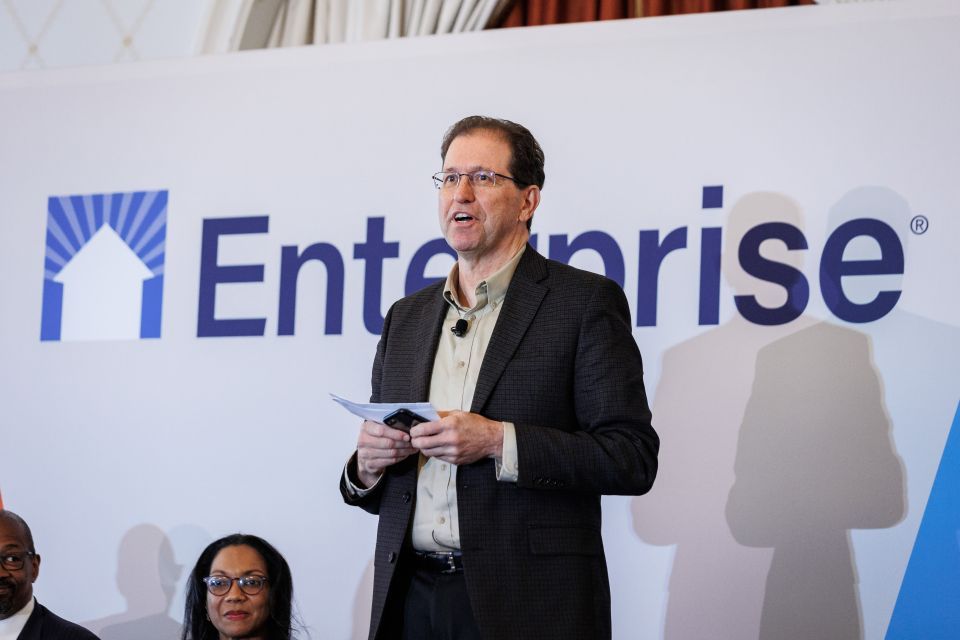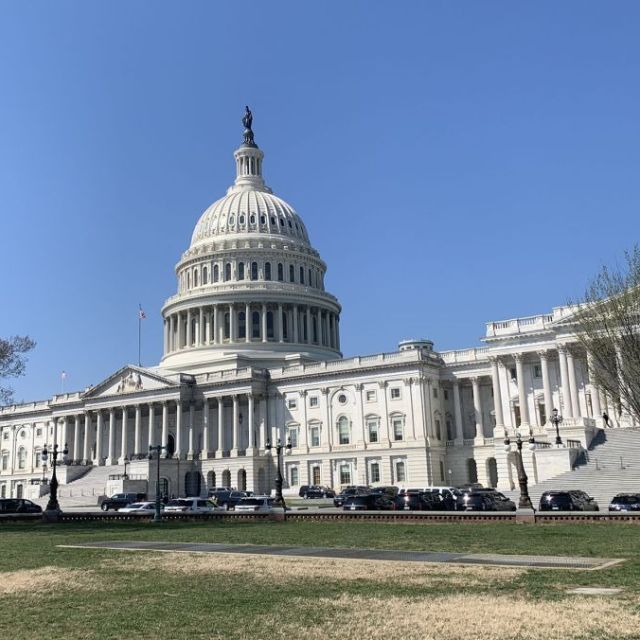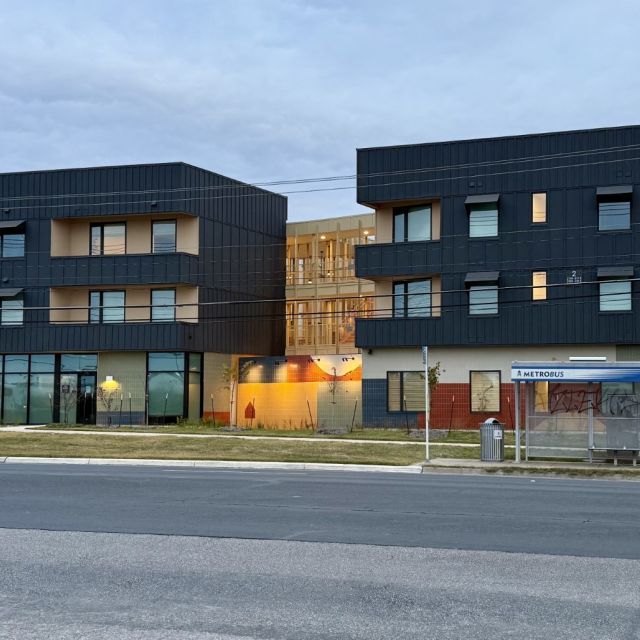While continued market uncertainty could cloud the outlook for affordable housing and community development in 2024, Enterprise leaders see reasons for optimism and the potential for significant opportunities.
“Despite sustained headwinds over recent years, there are positive signs ahead,” said Scott Hoekman, president of Enterprise Housing Credit Investments. “Inflation has declined, and the economy overall is strong. All of this points to a year where some of the volatility and uncertainty finally blows out through the system.”
We spoke with Hoekman and other Enterprise capital experts about affordable housing and community development trends this year.
On the Low-Income Housing Tax Credit
Higher interest rates and market volatility have put pressure on housing development for another year. As these uncertainties continue, what’s your production forecast for the coming year?

Scott Hoekman: Let’s start by looking back to 2023. Despite all the volatility and challenges of this past year, we and our capital and development partners were able to close a lot of strong affordable housing developments in 2023. We’ve notched our fifth consecutive record year of production in housing credits. That’s the good news.
For 2024, we’re forecasting a bit less production due to continuing higher costs and interest rates. We’re still feeling headwinds, some of which may have a greater impact this year. Generally, we have a strong pipeline for the year ahead, but we know there will be challenges, and some projects will need retooling to be feasible. An additional consideration is that we're also seeing some increase in yield expectations from investors, and that is putting constraints on the price per credit and the equity for deals.
That said, we’ll work with our partners to solve these feasibility challenges and hopefully end up close to our investment levels of recent years, and we’ll be poised to continue to be successful in 2025.
What are your top policy priorities for 2024? How would passing the Affordable Tax Credit Improvement Act change the LIHTC landscape?

Kari Downes: We worked hard all last year to build support for the Affordable Housing Credit Improvement Act. Our aim was to get at least some provisions of the act into any moving tax vehicle. We’ve surpassed 200 co-sponsors in the House, and co-sponsorship in both the Senate and the House is very bipartisan.
We’re very excited about the recent news that congressional leaders have agreed on a tax package that strengthens and expands the housing credit by restoring a 12.5% allocation increase for 2023 – 2025 and lowers the 50% bond financing test to 30% for 2024 – 2025. These provisions are expected to create and preserve 200,000 additional affordable homes over the next two years.
Although we have a way to go in getting this tax package over the finish line, it was a major lift to get the Housing Credit into the bill at all, and its resounding approval by a vote of 40-3 in the House Ways and Means Committee is very encouraging.
This is likely the last real opportunity for substantial Housing Credit legislation until 2025, and Enterprise and our advocacy partners will be working tirelessly in the coming days and weeks to get this package enacted.
On Preservation and Real Estate Equity
How are current and anticipated interest rates affecting existing affordable housing portfolios? How might they impact acquisitions in 2024?

Chris Herrmann: When interest rates rise as much and as quickly as they have in the last 18 months, there are lots of implications. We're seeing that manifest in some difficult situations in the markets we serve. As interest rates rise, the value of commercial real estate generally declines. Some owners bought their buildings for more than they're worth now, while others who built or bought their buildings many years ago and had positive equity have seen that equity shrink. All owners are feeling it to some degree.
A more acute issue is when properties have floating rate debt on them—somewhat less typical in affordable housing compared to other commercial real estate, but not unprecedented. Those properties have experienced a significant increase in debt service payments, either because interest is higher or the cost of replacing an interest rate cap is. That means money that ordinarily goes back into the building is being spent on interest or allocated to escrows, leading to deferred maintenance. We’re seeing some renovation plans come to a stop because owners simply can't afford them anymore due to these cashflow challenges.
On the other side of the coin, though, because property values are lower, we’re optimistic that there will be better buying opportunities than we’ve seen in many years. We might also see more opportunity for appreciation. We're excited about that from a new investment standpoint.
What can help accelerate the preservation of affordable homes in the year ahead?
Chris Herrmann: The best thing that could happen is stabilization of the market. Near the end of 2023, we saw the 10-year treasury yield go from 5% to under 4%—that’s a swing of over 100 basis points in a very short amount of time. That unpredictability is an enormous challenge. If the market were more stable for financing, I think we’d see more transaction activity and more preservation opportunities as a result. Private capital has been on the sidelines, waiting to see what happens with interest rates.
In the meantime, state and local incentives are popping up around the country that can augment private capital and positively influence preservation outcomes. Great examples of that include providing a property tax exemption if there is an affordability requirement. We see some kind of property tax exemption program in many states—California, Colorado, and Washington, and increasingly Maryland, Florida, and Texas—but there's a lot of work to do to make these programs more prevalent and effective. Through Enterprise’s state and local policy initiatives, we’re bringing resources and innovations to the market so these best practices can become more mainstream in more places.
Another way to extend capital is through a subsidy during acquisition. In addition to the debt and equity we access in the private market, the public sector comes to the table with a portion of financing at a discounted rate, or a willingness to take a higher risk in the capital stack. For example, a state or county can provide supporting financing to landlords committed to a certain level and term of affordability.
The Inflation Reduction Act is also chock full of subsidies for augmenting the cost of retrofits.
And we’re really excited to see what Greenhouse Gas Reduction Fund awards bring to our industry in terms of capital subsidies for energy efficiency improvements and decarbonization. It all remains a bit under development, but we're very optimistic that these resources will not only help us accomplish decarbonization goals, but also contribute to our affordable housing goals as well. Reductions in utility consumption and costs puts less pressure on topline rents, and new sources of funding could make the production and preservation of more affordable homes possible.
On Community Development Financial Institutions
With relatively high inflation and interest rates, and other disruptive market forces continuing into the new year, what sorts of challenges—and opportunities—are you anticipating in community development?
Elise Balboni: A challenging market actually generates more demand for lower-rate, flexible CDFI financing. Inflation and higher interest rates create a series of cascading gaps in a project’s construction and permanent financing sources. Meanwhile, operating properties struggle with the combined effects of increased operating costs, like inflation and rising insurance premiums and reduced revenue from lower economic occupancy—some residents might not be paying rent on the units they occupy due to the lingering impacts of eviction moratoriums. This is resulting in thinner cash flows and lowers the amount of conventional debt a project can support. The record $279 million in financing Enterprise Community Loan Fund provided in 2023 was in response to this increased demand for flexible financing to fill gaps and keep projects moving.
As a whole, the CDFI industry also experienced much slower portfolio turnover in 2023, with many borrowers requesting extensions due to delays in assembling takeout financing amid these disruptive market forces. The result was burgeoning portfolios and an inability to recycle lower-priced capital sources raised in the lower interest rate environment to the same extent we’ve historically done. With interest rates too high from our historic lending partners—Community Reinvestment Act-motivated banks, insurance companies, et cetera—because of the market environment, some CDFIs have had to slow their new financing activity, while others have had to borrow at market rates and charge significantly higher rates to borrowers that could afford them.
On the flip side, CDFIs began 2023 with elevated net asset ratios due to significant grant support in the wake of COVID-19 and the racial justice movement. The higher interest rate environment has also meant higher interest earnings, both on cash balances and on larger outstanding portfolio balances, which means that net asset ratios remain strong. In the high interest rate environment, there is also the opportunity to expand our capital sources and investor base more broadly to impact-oriented investors: donor-advised funds, high net worth individuals, family offices, and retail investors through CDFI impact note programs like the Enterprise Community Impact Note.
In July of this year, we co-published with LISC the third in a series of white papers positioning CDFIs as impact investments. This installment highlights the range of options available to investors, including 19 unrated note programs offered by CDFIs. Regional CDFI coalitions are also advocating for new funding. The California Coalition for Community Investment spearheaded the creation of a new statewide CDFI fund, the California Investment and Innovation Program, which is modeled after the federal CDFI fund and just gave out its first round of grants to CDFIs operating in California. And the Washington Community Investment Coalition created a new tax credit program in partnership with the Washington Department of Commerce to award grants to CDFIs through business and occupancy taxes that businesses across the state pay.
How will CDFIs play a role in helping vulnerable communities manage climate risks?
Elise Balboni: CDFIs are well positioned to be intermediaries as we transition to the green economy. They have a strong track record of climate justice and lending. For example, 55% of Opportunity Finance Network’s members—a national network of more than 400 CDFIs—offer green lending products, and OFN has called on the industry to increase that number to 100% by 2028.
Many CDFIs and CDFI industry groups are members of coalitions applying for the three GGRF competitions, too. Enterprise is part of the Power Forward Communities application to the National Clean Investment Fund with Habitat for Humanity International, Local Initiatives Support Corporation, Rewiring America, and United Way Worldwide. I think the GGRF will ensure that all of us provide a diversity of green products going forward—and CDFIs will help ensure that low-income communities and residents benefit from the clean energy transition.
Learn more about Enterprise’s products for investors.



